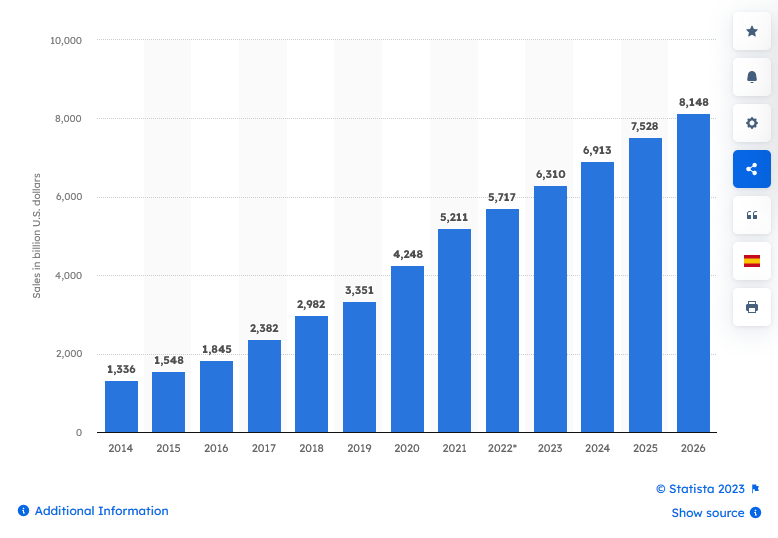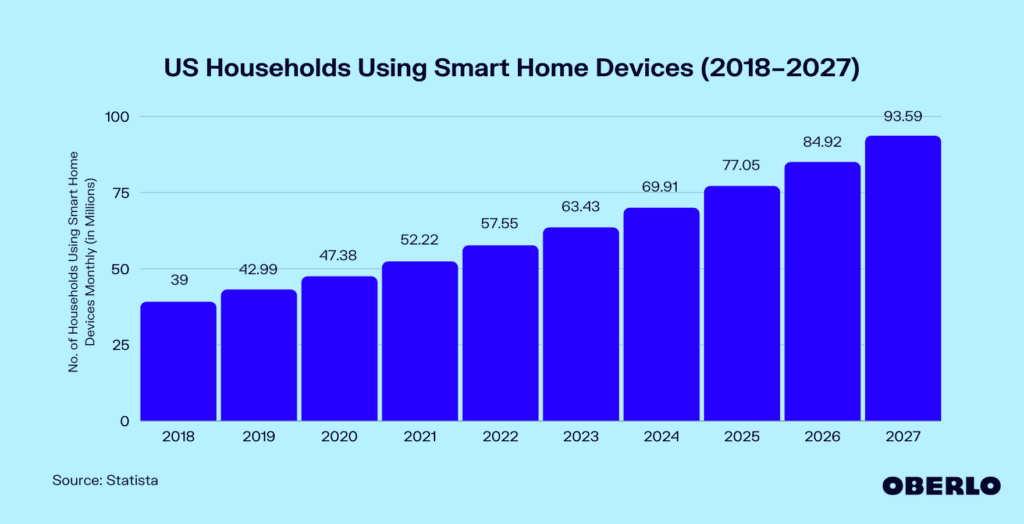eCommerce has changed how companies work and how people shop in the digital age we live in now. With technology always getting better and customer habits changing, the future of eCommerce is full of exciting opportunities for Shopify merchants.
This piece will talk about the predictions and trends that are changing the eCommerce world, with a focus on how Shopify merchants can stay ahead of this competition.
eCommerce, which means “electronic commerce”, is when people buy and sell things over the Internet. It has become an important part of modern business strategies because it offers growth and expansion possibilities that can’t be found anywhere else.
According to a recent study by statistics, eCommerce sales reached a staggering $5.7 trillion in 2022, and experts project that this number will surpass $8.1 trillion by 2026.

Businesses can say how important an eCommerce website is. It lets companies reach people all over the world, gets rid of geographical limits, and gives users 24/7 access and convenience. Now that there are more online marketplaces and digital storefronts, companies can reach more people than they could before.
Shopify has become a popular choice for entrepreneurs and businesses of all kinds among the best eCommerce platforms that are out there. Shopify powers more than 1.7 million businesses around the world.
It has a full set of tools and features for creating, managing, and optimizing online shops. It is a go-to tool for eCommerce success because of how easy it is to use, how much you can change it, and how many apps you can use with it.
Before we go ahead, do you know what is the success rate of the Shopify store?
The Shopify Success Rate of eCommerce stores is around 5% to 10%. This means that out of every 100 businesses that use Shopify, only about 5 to 10 businesses of them are successful.
Learn more in our tutorial on Shopify success rate.
In the parts that follow, we’ll go into more detail about the trends and predictions that will shape the future of eCommerce for Shopify merchants.
We will talk about how new technologies like artificial intelligence and virtual reality, as well as the importance of mobile shopping and omnichannel integration, will change the way e-commerce works.
We will also talk about how important it is for Shopify sellers to use social commerce, subscription-based models, sustainable practices, and go global.
Shopify merchants can set themselves up for long-term success in the constantly changing eCommerce industry by staying on top of these trends and taking advantage of the possibilities they offer.
What is the Future of eCommerce:
The future of eCommerce is bright, with a compound annual growth rate (CAGR) of 23.5% from 2022 to 2028. This growth will be driven by a number of factors, including the increasing popularity of online shopping, the development of new technologies such as artificial intelligence (AI) and machine learning (ML), and the growing demand for sustainable practices.
In the future, eCommerce will be seamless, personalized, and sustainable. AI and ML will be used to power personalized recommendations and customer service, blockchain technology will be used to track the provenance of goods and ensure transparency in supply chains, and sustainable practices will be embedded into every aspect of the eCommerce process.
Here are Some of the Key Trends that will Shape the Future of eCommerce:
- Personalization: AI and ML will be used to power personalized recommendations and customer service. This will allow eCommerce businesses to provide a more tailored experience for each individual customer.
- Sustainability: Sustainability eCommerce will become increasingly important to consumers. eCommerce businesses will need to adopt sustainable practices to meet the demands of their customers.
- Blockchain: Blockchain technology will be used to track the provenance of goods and ensure transparency in supply chains. This will help to build trust between eCommerce businesses and their customers.
- Social Commerce: Social media for eCommerce will continue to grow in popularity. This is where social media platforms are used to sell products and services.
- Voice Commerce: Voice commerce is another trend that is expected to grow in popularity. This is where voice assistants are used to make purchases online.
- Augmented Reality (AR) and Virtual Reality (VR): AR and VR will be used to create immersive shopping experiences. This will allow customers to try on clothes, see products in their own homes, and more.
The future of eCommerce is exciting and full of potential. By embracing these trends, eCommerce businesses can create a more sustainable, personalized, and seamless shopping experience for their customers.
So let’s dive in and find out what exciting things the future of eCommerce has in store for Shopify businesses.
Technological Advancements Shaping the Future of eCommerce:
Technological advancements are playing a crucial role in shaping the future of eCommerce, revolutionizing how businesses operate and how consumers engage with online shopping.
Let’s explore some key advancements and their impact:
1. Automated Shipping for Quick Delivery:
As eCommerce has grown, customers have come to expect quick and easy delivery. Automated shipping systems powered by robotics and artificial intelligence (AI) are easing order fulfillment, reducing human mistakes, and speeding up delivery times.
Recent data shows that 63% of customers expect delivery within three days. This shows that the need for faster shipping options is growing.
2. Physical and Digital Connections that Work Together:
Integrating physical and digital outlets is becoming more and more important for the success of eCommerce. Technology like the Internet of Things (IoT) gadgets and smart shelves are being used by retailers to make shopping easier.
For example: Customers can use their phones to check on the availability of products, place orders, and even pay for things while they are shopping in-store.
This coordination makes shopping easier and improves the whole experience.
3. Easier Ways to Pay:
The future of eCommerce is going in the direction of more easy ways to pay. People are using mobile wallets, digital funds, and buy-now-pay-later services more and more.
The global mobile payment market is expected to hit $18.84 trillion by 2030, according to the most recent data. This shows that people are becoming more interested in easy and safe ways to pay.
4. Surge in Mobile eCommerce and Increased Sales:
Since smartphones and mobile apps have become more popular, there has been a big rise in mobile eCommerce.
Today, more and more people use their mobile gadgets to buy things online, making them the main way to shop. Mobile devices have changed the way people use e-commerce because they are easy to use, portable, and easy to get to.
In 2021, a huge 6% of eCommerce sales came from mobile commerce in the US, which shows how important it is to the business.
Businesses must make mobile optimization a top priority if they want to take advantage of this trend. This includes making websites that work well on mobile devices, using responsive designs, and making mobile shopping easier.
Customers will be happier and more likely to buy from you if you make mobile shopping easy and smooth. This will also increase your conversion rates and sales.
With mobile technology getting better all the time and more people using smartphones, mobile eCommerce is likely to keep growing in the future.
Businesses that catch on to this trend and invest in mobile strategies will have a good opportunity to leverage the increasing number of mobile customers and boost sales in the eCommerce world.
If you want to increase your Shopify store sales, here is a complete guide on how to increase your sales with proven strategies.
5. Personalized Communication and Customer Service Through AI and Chatbots:
AI and robots are changing the way customer service works in eCommerce. Chatbots that are powered by AI can help customers right away and give them personalized suggestions based on their tastes and browsing history.
This level of personalization makes customers happier and helps companies build stronger relationships with their customers.
We’ll talk more about this later.
6. Search Through Visual Stimuli:
Visual search technology completely changes how people find and buy things online. This new trend lets people look for things by using images instead of text queries. By uploading a picture or using the camera function, shoppers can easily find similar goods or browse related items.
Advanced algorithms and machine learning are used by visual search technology to study and understand images. This makes it possible to find objects, patterns, colors, and textures. Visual search is expected to become even more popular in the coming years, thanks to the rise of sites like Pinterest, Google Lens, and shopping tools on social media.
Based on what experts say about the future of eCommerce in visual search, it is said to make up over 50% of all searches in 2023, which shows how important it is becoming in eCommerce.
This trend not only makes it easier and faster to find products, but it also gives shoppers a more interesting and personal shopping experience.
Businesses that optimize their websites and product catalogs for visual search will be in a better position to attract and keep the attention of buyers who are good with technology.
5. Alignment of Goals with Social Initiatives:
In today’s socially aware world, consumers are looking for brands that show a real commitment to social and environmental issues.
Businesses can’t just focus on making money anymore; they also need to make sure their goals are in line with social efforts so they can reach their target audience.
By using sustainable eCommerce practices, promoting diversity and inclusion, supporting charitable causes, and taking a stand on social issues, eCommerce brands can show what they stand for and connect with their customers on a deeper level.
Recent polls show that 86% of consumers think that businesses should take a stand on social media. This shows that more and more people expect businesses to be socially responsible and that this has a big effect on how people think about businesses and what they buy.
Socially-focused eCommerce businesses help make the world a better place and build trust, loyalty, and long-term connections with their customers.
By putting social responsibility into their business plans, companies can set themselves apart from competitors, have a positive effect on society, and drive eCommerce success all at the same time.
6. Machine Learning Taking Customer Experience to a Whole New Level:
In eCommerce, systems that use machine learning are changing the way customers interact with websites. By looking at a lot of data about customers, machine learning models can guess what customers will like, make personalized product suggestions, and make the shopping process better.
This amount of customization makes customers happier and increases the number of people who buy from you.
7. The Impact of Apple iOS15 and iOS16 Updates in the Long Term:
Apple’s improvements to iOS have a big effect on eCommerce. With iOS15 and iOS16, Apple added more privacy features that affect how data is tracked and how personalized ads are made.
7. The Impact of Apple iOS15 and iOS16 Updates in the Long Term:
Apple’s improvements to iOS have a big effect on eCommerce. With iOS15 and iOS16, Apple added more privacy features that affect how data is tracked and how personalized ads are made.
By using these new technologies, eCommerce companies can stay ahead of the curve and offer better shopping experiences, which will keep customers coming back and help them make more money.
Trends Shaping the Future of eCommerce:
The future of eCommerce is being shaped by various trends transforming how businesses operate, and consumers engage with online shopping. Here are some key trends to watch out for:
1. New Marketing Channels that are Emerging:
Traditional marketing methods aren’t enough to get the attention of customers today. New ways to market, like social media sites and marketing through influential people, are becoming more popular.
Recent studies show that 54% of consumers find out about new goods through social media and 49% trust what influencers say.
To connect with their target audience successfully, businesses need to have a strong presence on social media, work with influencers, and use user-generated content.
2. The Ongoing Physical vs. Online Debate:
The discussion about whether people should shop in places or online is always changing. Online shopping is more convenient and easy to get to than buying in a store with walls and floors. A hybrid method is becoming more popular. It combines physical and digital elements.
Augmented Reality (AR) and Virtual Reality (VR) are being used by businesses to create more realistic online experiences. By making it easy to shop both in person and online, businesses can meet the needs of a bigger range of customers.
3. The Rise of Voice Search Among Consumers:
As mentioned above, voice search is becoming more and more common as virtual helpers like Siri, Alexa, and Google Assistant are used more and more. Oberlo data show that by 2027, 93.59 million homes will have a smart speaker in the US only.
To make their content and product descriptions work well with voice search, businesses should use long-tail terms and conversational language. By preparing for voice search, businesses can get more attention and reach a wider audience.

4. Automation and its Impact on eCommerce:
As stated above, automation changes many parts of eCommerce, from keeping track of goods to helping customers.
Automation simplifies processes, cuts down the mistakes made by people, and makes operations more efficient.
Businesses can use automation to do things like process orders, restock inventory, and run personalized marketing campaigns. This lets them focus on key projects and give customers a smooth experience.
5. The Increasing Prevalence of Private Label Products:
Private label goods, which are also called store brands or in-house brands, are becoming more and more popular in eCommerce. These goods have higher profit margins, better quality control, and aren’t sold anywhere else.
The market study shows that in 2022, sales of private-label products will have reached $228.6 billion. Businesses can take advantage of this trend by making private-label goods and using the reputation of their brand to attract customers who want to try something new and cheap.
6. Emphasis on Sustainability by eCommerce Brands:
Sustainability and doing the right thing are becoming more important to consumers. As a result, eCommerce brands are building sustainability into their business plans.
A survey found that 88% of people want brands to help them be better for the earth. Businesses can appeal to customers who care about the environment by using eco-friendly packaging, promoting sustainable sourcing, and getting involved in social projects.
Businesses can get loyal customers and help make the future greener by making sure their brand ideals are in line with sustainability.
Future of eCommerce for Marketers:
Here, we’ll talk about the most important things that marketers should focus on to have the most impact in the digital market.
1. Importance of Device Usage in eCommerce Strategies:
It’s important to optimize mobile devices because computers and smartphones are becoming more and more popular. Mobile eCommerce is growing quickly, and data shows that in 2023, 43.7% of all eCommerce sales will be made on mobile devices.
Marketers must make mobile optimization a top concern by making sure websites are flexible, checkout processes are easy, and content is made for mobile devices. Marketers can get customers’ interest and get them to buy by making it easy for them to use their phones.
2. The Key to Success: Making Things Unique:
The way that eCommerce marketing is done has changed because of personalization. Customers want experiences that are tailored to their own likes and needs.
Marketers can make personalized product ideas, offer customized deals, and run targeted marketing campaigns by using customer data and technologies like artificial intelligence (AI) and machine learning.
Marketers can increase average order value, customer engagement, loyalty, and sales by giving customers experiences that are useful and tailored to them.
3. Putting the Customer Experience First to Get More Sales:
The most important thing in the competitive world of eCommerce is how the customer feels. Customers like having easy access, tools that are easy to use, and good customer service.
Marketers should make it easy for customers to check out and give them more ways to get in touch with them.
By putting the customer experience first, marketers can make customers happier, make it less likely for customers to leave their shopping carts, and increase conversion rates.
4. AI and Chatbots Can Be Used as Personal Assistants:
As was already said, AI and robots are making a big difference in how customer service is done in eCommerce. With these tools, you can get help at any time, get answers right away, and get ideas that are just right for you.
AI-powered chatbots can answer simple questions, tell you about goods, and make transactions simpler.
Marketers should use chatbots as part of their customer service strategies to cut down on response times, get customers more involved, and make them happy. Marketers can help a lot of customers quickly and personally by using AI and robots as personal assistants.
5. Interactive Goods are Becoming More Popular in eCommerce:
More and more eCommerce customers want to connect with the products they buy. With the help of technologies like augmented reality (AR) and virtual reality (VR), customers can see how things will look in their homes.
They can also try on clothes virtually and move furniture around to see how it looks. Marketers can make it easier for customers to find goods, get them interested in them, and make them more likely to buy by giving them interesting experiences.
Marketers can set their brands apart, get customers more involved, and make more sales by giving customers interesting and interactive experiences.
Conclusion:
To sum up, Shopify sellers can look forward to exciting growth and new possibilities in the eCommerce market. We’ve looked at a few important trends that are changing how eCommerce works, like the rise of private-label goods and the focus on sustainability.
Shopify sellers who want to do well in this industry, which is always changing, must change their methods, keep up with new trends, and use technology.
Along with interactive products, important areas to work on to keep customers excited and give them a better shopping experience are mobile optimization, customer experience, and the use of AI and chatbots for personalization.
In the future of eCommerce, Shopify merchants will do well if they know about these options and can come up with new ideas over time.
Cirkle Studio is an expert at making Shopify stores, so they can help you with any problems or questions you have about your eCommerce business. Contact us at any time if you need help adjusting to changes in your business, such as the latest digital commerce trends.
We think that the future of eCommerce looks very bright, and if Shopify sellers take action now, it will help them all do well in the future.








